
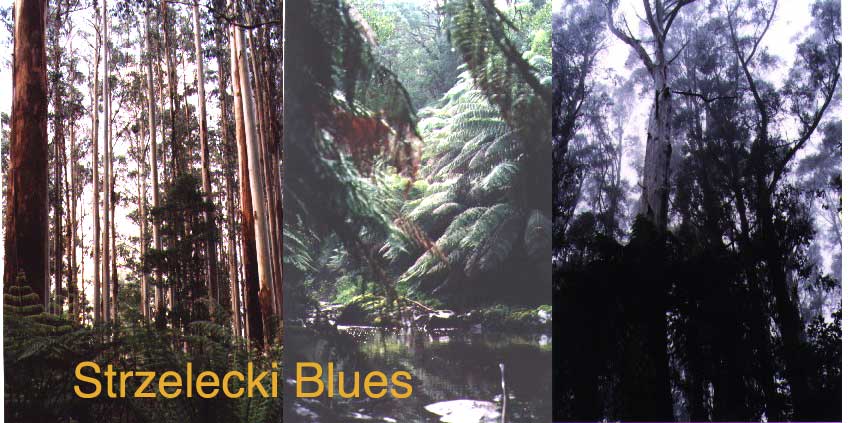

West Gippsland is the area marked by the black line in the picture above.
It takes in some of the highlands south of the divide, the Latrobe Valley,
lowlands around Lake Wellington, the Strzeleckis, the South Gippsland lowlands,
and Wilson's Prom. The timber industry are mostly interested in the highlands
(green) and the Strzeleckis (purple), in particular the Wet Forests and
the Damp Forest areas therein. The region has been logged unsustainably
for decades, and finally in 2002 a Sustainability Review was commissioned
by the State Government. It found that the West Gippsland region
was the most over-allocated region (after the Midlands) in the state, and
that Sawlog quota from West Gippsland State Forests needed to be HALVED.
The State Goverment acted on this advice, radical as it may seem, and produced
their "our forests our future" strategy document. At the same time, the
State Government gave Amcor permission to expand their paper mill (located
near Morwell) and increase their hardwood intake. Where was this extra
wood going to come from when the harvest quotas in the region had just
been so dramatically slashed?

Strzelecki Bioregion: approx. 300000 ha.
Remaining Vegetation cover 60,000 approx (about 20% of bioregion)
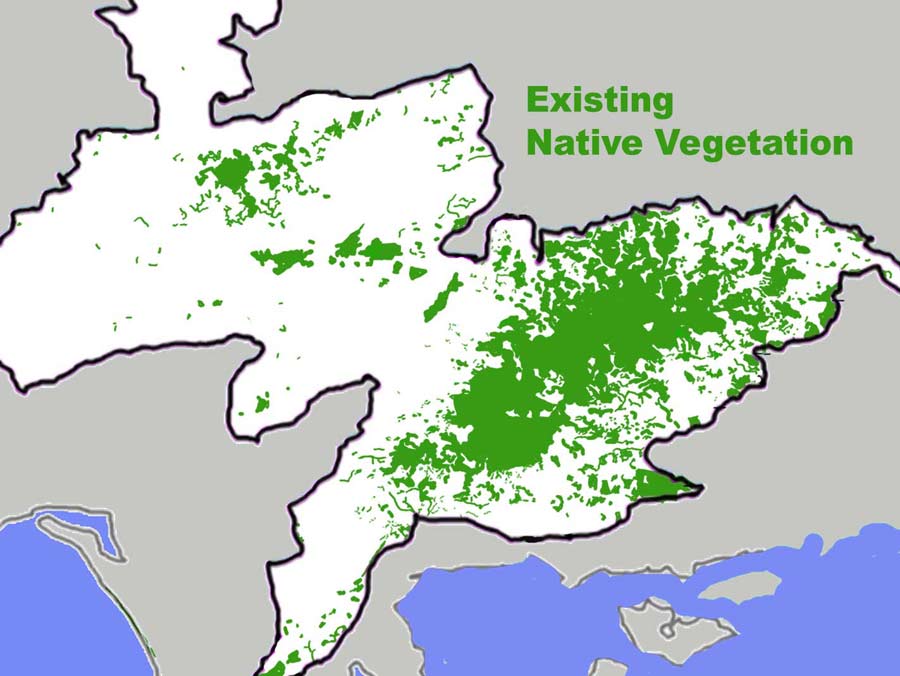
Scale: This map and many of the maps below are of an area roughly 85
km. by 60 km.
Much of the Strzelecki forest is a mosaic of Wet Forest and Cool Temperate Rainforest. The Wet Forest is dominated by the towering Mountain Ash forest with a diverse undertorey; the rainforest is most often found in the gullies, comprising a myriad of ferns, Myrtle Beech and Sassafras.
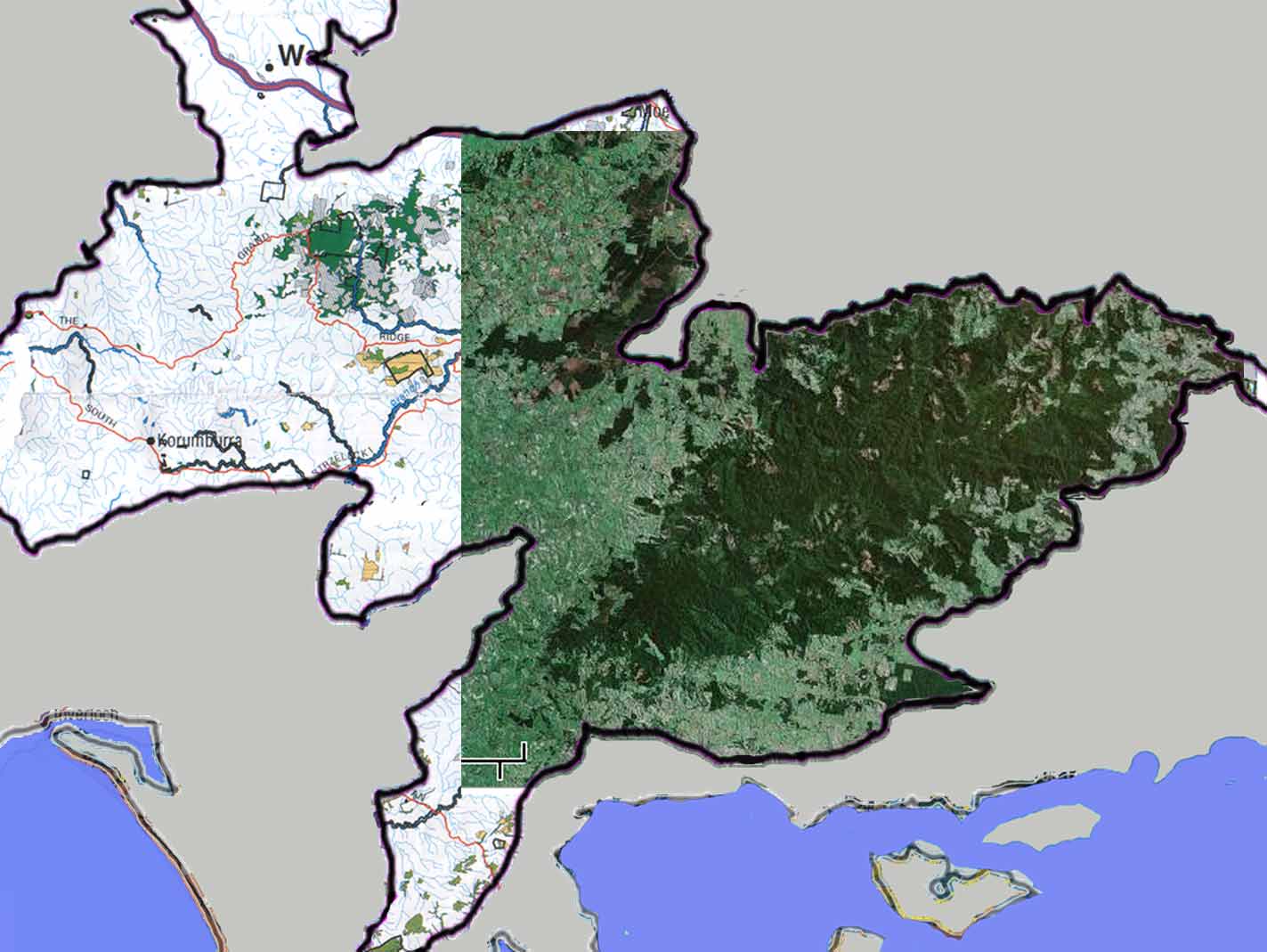
The Eastern Strzeleckis as seen by Aerial photography. Dark areas are
native forest as well as pine which is located around the outskirts. This
puts to rest any notions that the Strzelecki forest is gone. The Western
Strzeleckis are indeed largely bald, but in the Eastern Strzeleckis, the
forest is still there, and it is still quite big, and still quite cohesive,
save for the chunks of bare earth (greyish colour) which are areas of Native
Forest and Pine that had been clearfelled by HVP just prior to the photographs
being taken.
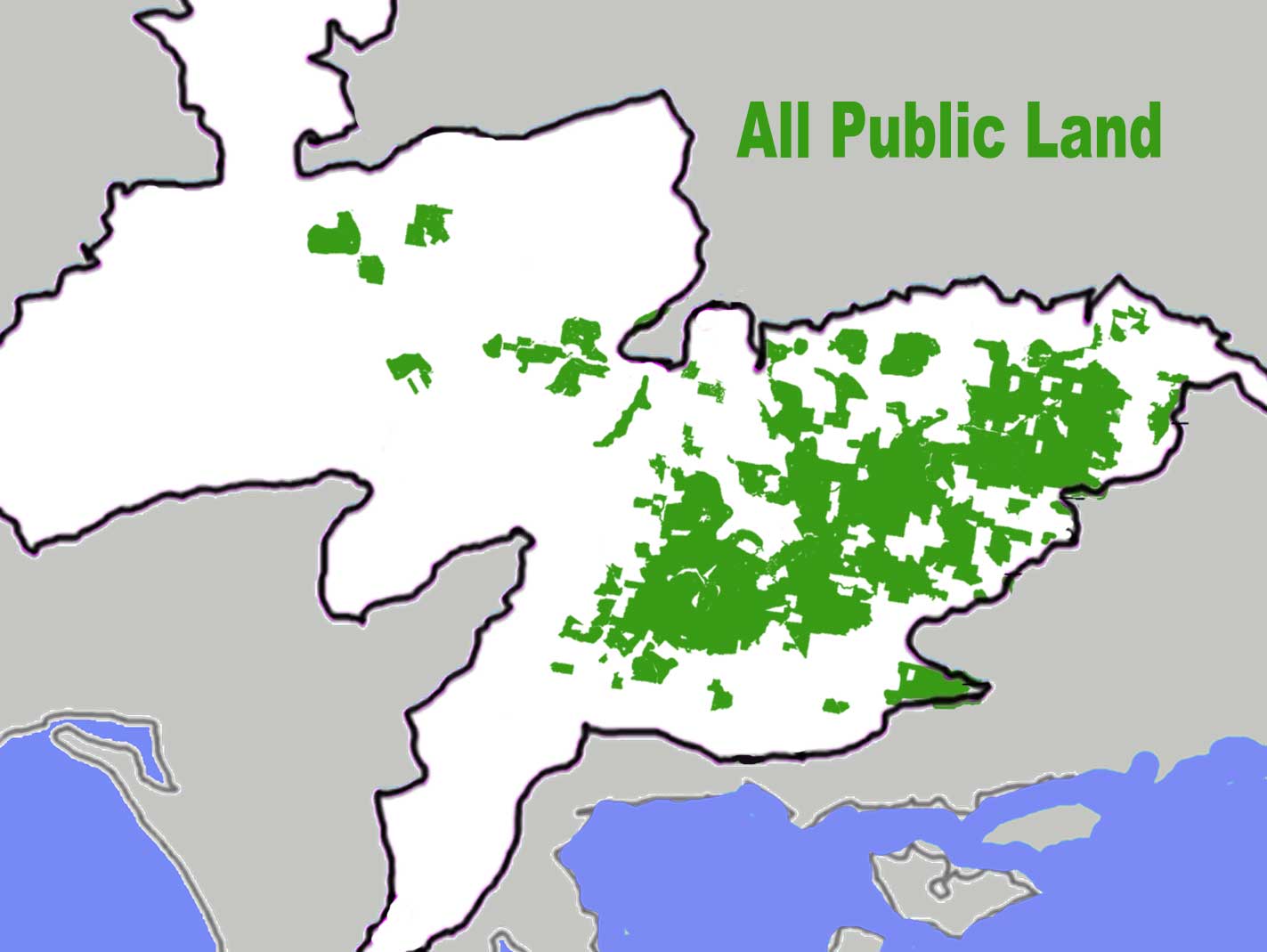
About 60,000 ha (20%) of the Strzeleckis land is Public land, although
about 13000 ha of this is pine plantations
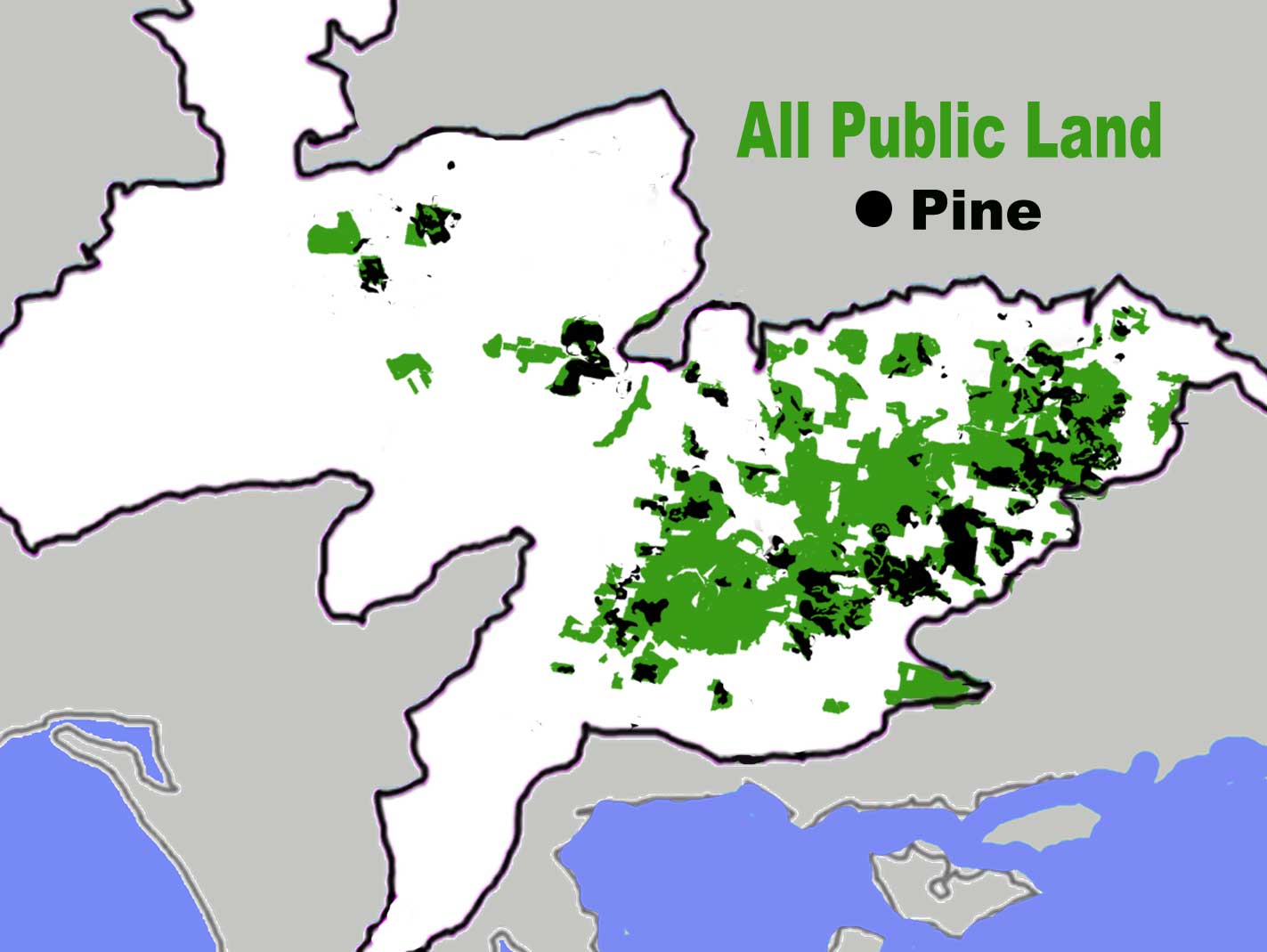
This shows the pine that was established on public land by the State.
Some pine was established on cleared ex-farmland that the State had bought
back, but Native forest was also cleared to establish pines. The controversy
surrounding the practice of clearing native forest to establish pine plantations
came to a head here in the Strzeleckis in the 1980s, and due to the persistence
of the local conservation groups and field naturalists, State Government
policy was changed and the practice was thankfully banned in State Forests
across Victoria as a result. But in the 1990s, the State Government dreamt
up a sneaky way to get around these, their own rules - they re-defined
all the regrowth native forest in the Strzelecki State Forest as "plantation".
More about that later...

Amcor (formerly known as APM) were given leasehold of 8600 ha of Strzelecki
State Forest back in the 60s (shown here in Gold)
This was rather too generous of the State Government, as the pulp and
paper mill, Amcor (aka: APM, Paperlinx, Australian Paper Plantations -
APP, Maryvale) already owned about 9% of the entire bioregion
as shown in Green in the map below
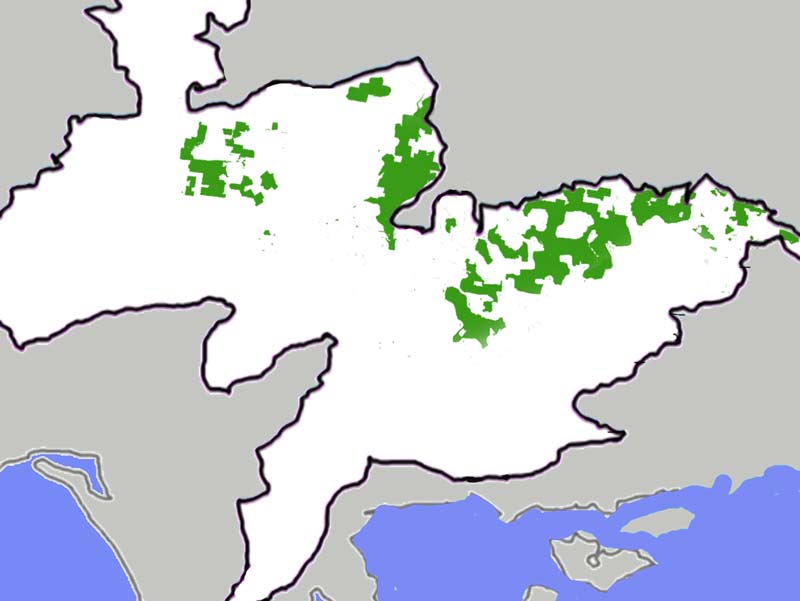
Amcor's private land in the Strzeleckis
How this Paper mill came to own such a vast tract of these ranges is
a whole separate story.
It all ties in with a very old relationship between APM and the Victorian
Government. APM began in old Melbourne town, but in the 30s relocated
to Maryvale. The government gave them rights over much of the timber resources
of West Gippsland as well as other incentives and ýresource securityţ in
the form of an act of Parliament.
From the 1940s through to the 80s, the State Government began buying
back many abandoned and untenable "farms" in the Strzeleckis, just as it
did in many other parts of the state, in order to consolidate and enlarge
our State Forests. Almost half of the public land in the Strzeleckis was
for a short time private, then bought back over a period when land was
extremely cheap. In the Strzeleckis, APM and the Government both took part
in this land buying program. By about the 80s, when this buyback had petered
out, the State and APM had bought a roughly equal amount.

In 1998, along with all of Victoria's State's pine plantations, Hancock Victorian Plantations (HVP), part of a US corporation, were sold the lease to almost all of the Strzelecki State Forest, an area comparable in size to Wilsons Promontory National Park. Along with the 13,000 ha. of Strzelecki State pine plantations, the leased State Forest contained about 27000 ha of Native Forest, 6500 ha. of which was reforestation and regrowth disgracefully mis-labelled by the State Government as hardwood plantation, taking away its native forest status.
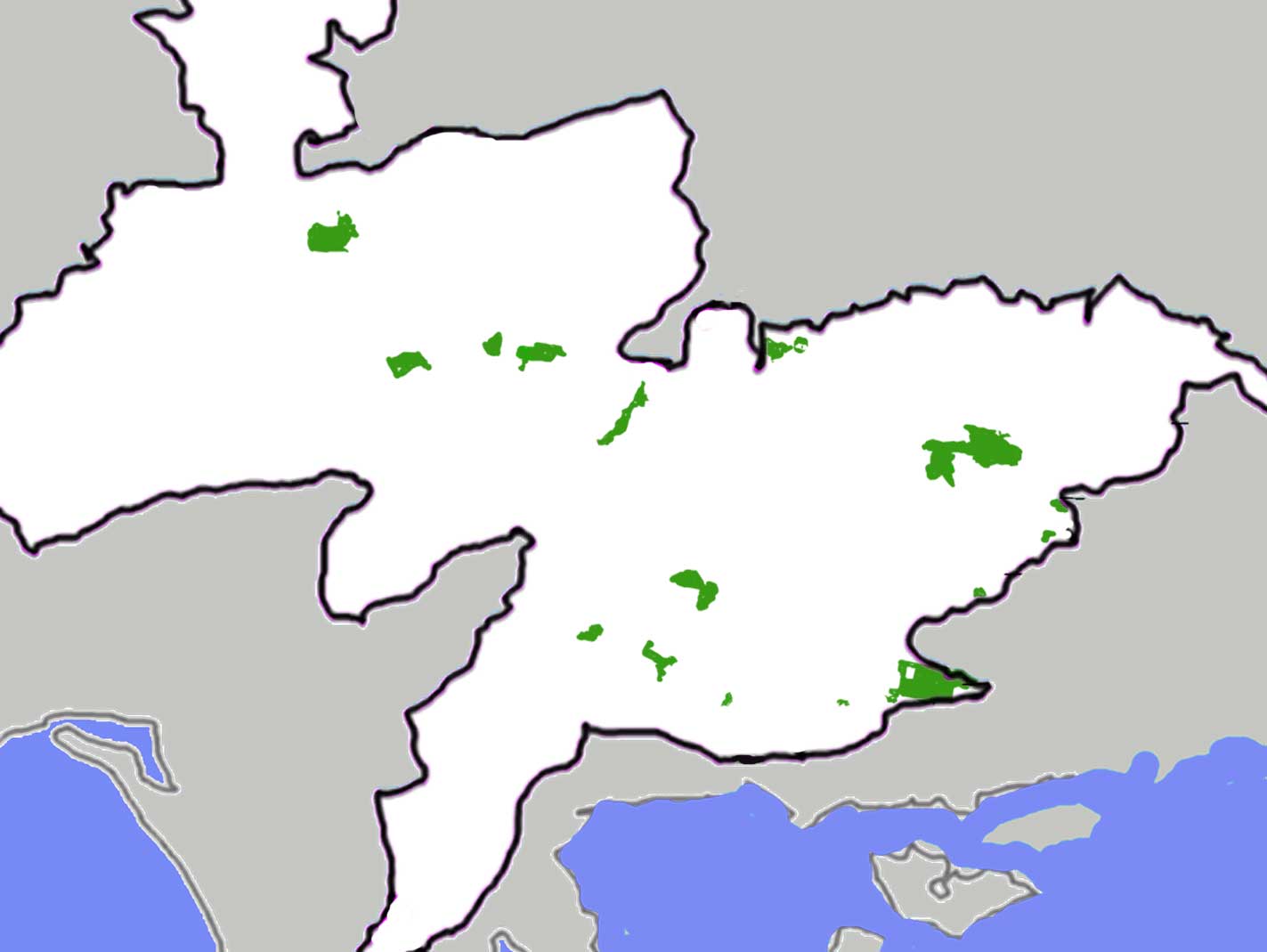
This left only about 10,000 ha of State Forest that hasn't been leased
(shown here in Green).
Of that, only about 5000 ha ( < 2% of bioregion) is
protected in reserves
In the Strzeleckis, leased public land is treated by the Government
as if Private land, so in processes such as the Regional Forest Agreements
and the Sustainability review, these bits shown above are the only areas
recognised as public land. All else is exempted from these processes. Given
this, you would think that the remaining 5000 ha. of non-leased, non-reserved
State Forest would be awarded extra protection, but no, it hasn't happened.
This is a bioregion hopelessly lacking an adequate reserve system. Less than 2% of the bioregion is protected in reserves. This falls way short of all the Government's own minimum benchmarks as set out in documents such as the Regional Forest Agreements and the Regional Vegetation Plan, which both (in a convoluted and complex way) say that a minimum of 15% of the bioregion should be protected in reserves. To reach this minimum, the Strzeleckis needs about 45000 ha of reserves, thats 40,000 more than it has at the moment.
Across the State of Victoria, about 48% of Public land is protected in reserves. In the Strzeleckis, only about 7% of public land is is protected in reserves.

When HVP bought out all of Amcor's 26,500 ha of Strzelecki freehold
(Shown above in Dark Green) and took over Amcor's 8600 ha. Strzelecki State
Forest leasehold in 2002, their Strzelecki land holdings increased to almost
74000 ha.
Almost one quarter of the entire bioregion is under the control of
a plantation corporation.
(light green: leased SF, dark green: freehold) The aquisition
brought a further 22,000 ha of native forest under their control. Now more
than 43,000 ha of Strzelecki native forest (more than 2/3rds of all that
is left) is under HVP management
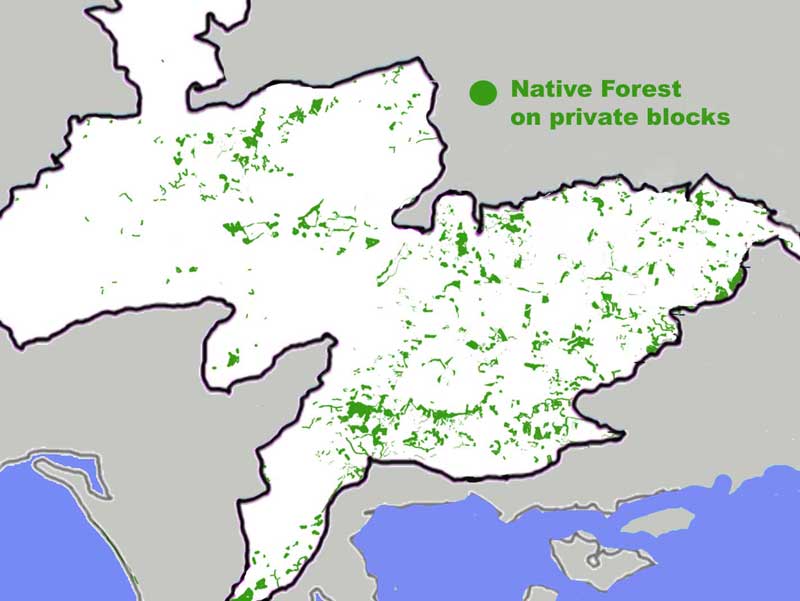
Taking away all HVP leaseholds , freehold and the bit that the State
Government didn't lease, the remaining 10,000 ha. of native forest occurs
on private blocks not owned by HVP.
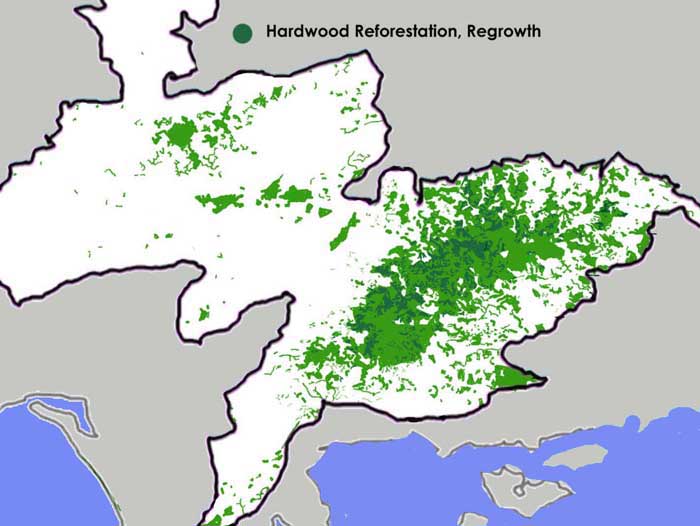
About 7000 or 8000 ha. of reforestation and regrowth (dark green) on
the now leased bits of the Strzelecki State Forest were re-classified by
the State Government in the mid 90s. They were Native Forest one day, then
with the stroke of a pen became "plantations"
Overwhelming evidence, including a recently released government commissioned
report, kept hidden since 1993, indicates that these areas are indeed native
forest, and that the change of status was absolutely contrary to Land Conservation
Council (LCC) recommendations. Yet, despite knowing all this, the Government
sold off these leases defining these areas as "plantation", and despite
having been given ample evidence that shows that this definition is wrong,
HVP continue to view them and treat them - these stands of native
Mountain Ash forest - as plantation, and have been clearfelling them at
an alarming rate since arriving.
This is the only State Forest in Victoria to have been privatised. How
did this happen?
Since about 1990, the State Government were planning to sell off their
pine plantations. In 1993, the State Government invented the Victorian
Plantations Corporation, a "State-owned enterprise". All the State's pines
were vested in the VPC, as well as nearly all of the Strzelecki State Forest,
(which wasn't part of the original idea at all). To justify doing this
to the Strzeleckis it was necessary for the State Government to lie, and
make out that the majority of what they were vesting was plantation. But
in reality, most of it was native forest. Having vested this land the State
Government then just had to privatise the VPC, which it did in 1998 when
it sold the whole bundle to American corporation, Hancocks. The land itself
was not sold - that would have been more tricky - just the corporation
and its assets.
In the document 'Land Conservation Council -Review of Victorian Plantations
Corporation Vested Lands -As requested by the Minister for Planning, August
1993', which was hidden till 2008, the LCC makes it clear that they are
concerned that native forest has been included in the land ývestedţ in
the Victorian Plantation Corporation, in preparation for privatisation.
They say, 'The most notable and extensive areas of included native
forest are those vested lands in the Strzelecki Ranges Í' They are
also disturbed by the 'inclusion of extensive areas of mountain ash reforestation
in the Strzelecki Ranges. These areas were recommended for hardwood
timber production by Council, which noted that the objective of the hardwood
planting was to restore the forest so that it will eventually have a similar
structure to the original forest. A range of uses were to be provided
and no differentiation was made between reforested areas and areas retaining
the original forest cover.'
The Strzelecki Reforestation Scheme was meant to tie in with the Strzelecki land buy-back scheme that went on between the 40s and the 80s. It was a scheme that was meant to restore native forest to those areas of re-purchased land that needed it. In reality, a great deal of the re-purchased land was cleared even more, sprayed with something suspiciously like Agent Orange, then turned into pine plantations. While some areas might have been assisted to regenerate into native forest again, often what occurred was that forest was logged, and the regrowth or regeneration referred to as reforestation. Whatever it was called, the areas formerly known as Hardwood Reforestation is native forest, and was officially recognised as native forest, until 1993 when the State Government sneakily changed its status to ýplantationţ during the ývestingţ process. Most of the "hardwood reforestation" is not the on the repurchased land but on the land that was always publicly owned.

These areas of reforestation and regrowth mis-labelled as plantation
have been the focus of HVP's orgy of clearfelling.
Because these areas had their native forest status taken away, HVP
has free reign to log it with no more restrictions that they would face
if it was a pine plantation. Once logged, they are usually replaced with
plantation blue-gum or shining gum. Effectively, they are clearing Mountain
Ash native forest and replacing it with plantation, a practice outlawed
in Victorian State Forests since the 80s. Yet, as these areas have had
their native forest status and their State Forest status cruelly withdrawn,
this practice can go on. HVP have their own act of parliament ensuring
the right to wreak havok on the Strzeleckis, set out in the Victorian
Plantations Corporation Act 1993
So, while the rest of region had to take a (necessary) 50% cut in sawlog
quota from State Forests, the Strzeleckis were opened up for even more
accelerated logging rates.
Now an even "huger" proportion of the region's wood harvest is going
on in the Strzeleckis.
HVP have on many occasions stated that their committment to supplying
Amcor's Maryvale mill with wood takes precedence over just about all else.
Nauseatingly, HVP representatives would talk of "mum and dad investors"
who "expect them to maximise returns on their investment", as if it was
their righteous duty to hammer the Strzeleckis. Unfortunately our
State Government will not confront the daunting presence of HVP in the
Strzeleckis, and will not address the dire lack of reserves and lack of
protection that the remaining bush in the Strzelecki bioregion endures.

This is all going on in order to feed Amcor's (Paperlinx) huge paper mill in nearby Maryvale, near Morwell. The native Mountain Ash goes to make Reflex copy paper. The impact of the Maryvale mill on the region's forest is equivalent to that of a major woodchip export base. No, worse actually: It has a water allocation of Humpteen Gigalitres, runs its own power station and provides many of the region's biggest effluent problems. Back and forth the trucks go every day, between Maryvale and the Strzeleckis, bringing load after load of Strzelecki Mountain Ash and Pine. Up goes the boomgate and in they go...

for a far more detailed look at HVP's deeds, go to the Hancock
Watch website
Sing Along Kids!...
Where did the trees go? Maryvale! Maryvale!
Chopped, Chipped and Boiled Down for Photo
Copy Paper!
Where's the baby lyrebird? In the nest!
Laid to rest!
Little downy feathers in our Photo Copy
Paper!
Wheres that sleepy Koala? In the tree!
Taken Awee!
Little bits of fur in our Photo Copy Paper!
Are the wombats there? They're still there!
Worse for wear!
Squashed by a logging truck on its way
to Maryvale!
Even more galling, the horrific quantities of Native Forest hardwood being chewed out of the Strzeleckis is marketed as "green" because it is "plantation" hardwood. Superannuation funds, even Environmental groups, have been conned into supporting this grotesque and scandalous Strzelecki feeding frenzy, misinformed by the central lie that the reforestation and regrowth is "plantation".
HVP's appalling Strzelecki "strip-mining" operations should never have
been granted FSC certification. In our opinion, Smartwood, the Indonesian-based
organisation that awarded them FSC certification are equally culpable.
We have provided them with great amounts of information yet they fail to
do their job, and have failed to address any of the issues we have raised.
We have no faith left in Smartwood whatsoever. Oh, and Smartwood have recently
changed their name to THE RAINFOREST ALLIANCE. This name change is psuedo-green
spin, and nothing more.
The push for reserves
Conservation was not invented in the 80s. The movement to protect native
forest in the Strzeleckis dates back 100 years. The lack of reserves in
the Strzeleckis has been an issue for a long time. The 5000 ha. of reserves
that do exist (and some are among Victoria's oldest) are the result of
massive, drawn out struggles conducted by local conservation groups, field
naturalists, local shires and the odd sympathetic politician. In every
case, the main hurdle was the State Government and its Forestry Department.
Every hectare was fought for and all that struggle has still only protected
5000 ha.
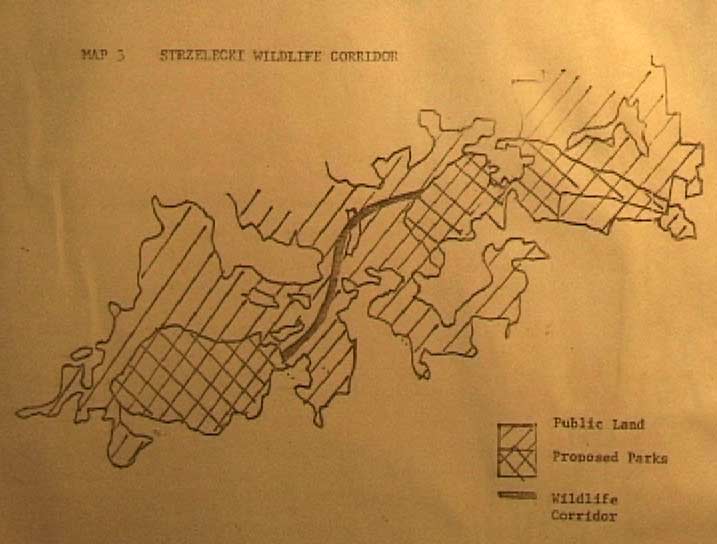
Part of a submission from the 80s
During the 80s, there was a great deal of work put into the idea of
a large reserve in the Eastern Strzeleckis, and on record are several very
elaborate submissions put to the Land Conservation Council on the subject.
While that decade saw Victoria's reserve system multiply in size, the Strzeleckis
were strenuously denied any significant conservation gains. Too close to
Maryvale.
We took up the issue in the late 90s, unaware of past attempts. We
became aware that the State Government had "Corporatised" and appeared
to be about to "Privatise" our State Forest. We did some research and decided
that before this should happen, about 50% of the public land in the Strzeleckis
should be made a National Park. We figured that this would simply bring
the Strzeleckis into line with the State Average, and provide a much-needed
counter-balance to the intensive flogging the rest of the State Forest
was set to recieve. In collaboration with Allan Standering, we released
"A Proposal for a 30,000 Ha. National Park in the Strzeleckis" in 1998.
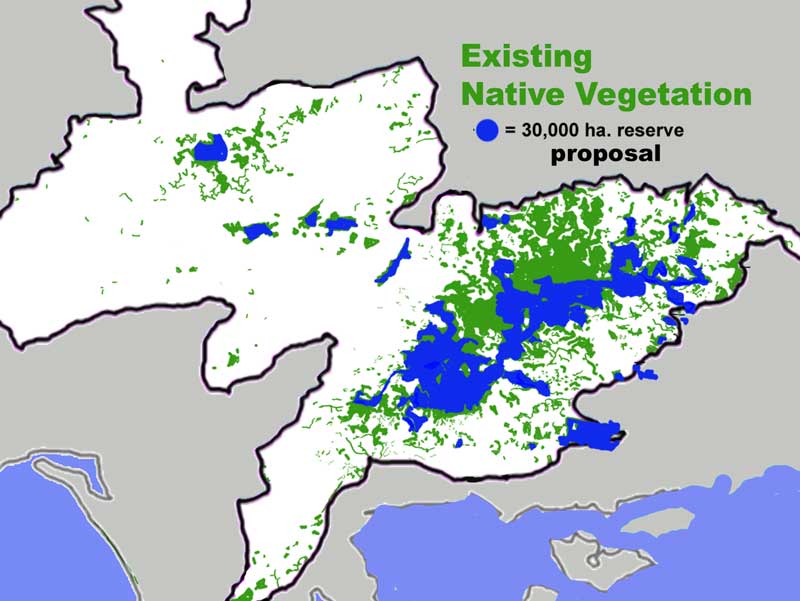
The idea was to bring together the 5000 ha. of existing reserves, the
5000 ha. of State Forest that wasn't going to be privatised, and 20,000
ha of State Forest that was either leased to Amcor, or about to be leased
to HVP. It avoided private land and pine plantations, took in all the most
worthy bits of bush, and left plenty of pine and forest for the timber
industry. The idea gained a lot of traction. A 7000 signature petition
supporting the idea was tabled in Parliament by independent MP Susan Davies
...Then a WORKING PARTY was formed, effectively halting all progress for
the next ten years. The Strzelecki Working party no longer meets..
The Working Party were largely in agreement that a greater reserve system was needed and decided that a scientific study was the way to go . After years of arguing over things, the working party decided to employ environmental consultants, Biosis to do a study to identify the most significant areas of bush, although they were restricted to looking at the public land leased to HVP. The map they came up with shows an area roughly 8500 ha. which became known as the "Cores and Links". It bears a strong resemblance to several proposals that came before, only more miserly. Disappointed that they had overlooked many significant areas, We questioned Biosis and were told that they thought that if they made the Cores and Links too big HVP would pull out. We found this a very unscientific way of making decisions, but all in all, Biosis have been pretty solid.

The Working party (HVP was part of this working party) unanimously agreed to call upon the government to reserve the Cores and Links, on the proviso that HVP was compensated. About one day's worth of Poker Machine revenue would have covered it nicely. HVP put a 2 year moratorium over the area, but 2 years, 3 years, 4 years passed and still the State Government would not come to the party, even though all the hard work had been done for them. The Department Of Sustainability and Environment clearly wanted the whole thing to fail. (probably HVP did too) Federal politician Christian Zahra managed to get a $5 million election promise from Federal Labor to "buy back the cores and links", but this came to nought when the Liberals won the election.

Eventually HVP turned very sour on the whole idea, and by the time the State Government was prodded into action, HVP were bumping up their asking price beyond what the State Government were willing to offer. Instead of just paying HVP the full amount that they wanted, they agreed to the most appalling compromise. This bizarre arrangement was signed off and officially announced in August 2008. The Cores and Links are to be logged first, then protected. The logging-then-protecting process is to take 20 years. 20 years!
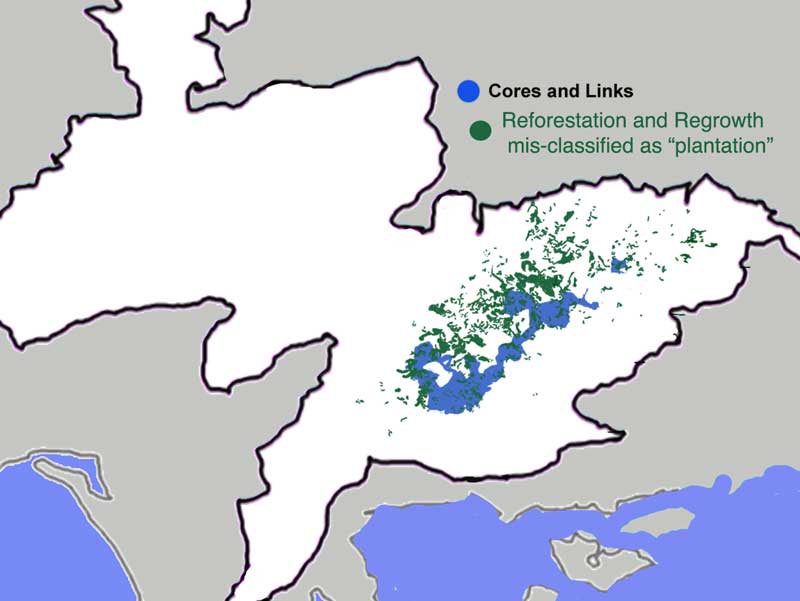
Notice that some of the reforestation and regrowth areas (judging by
newspaper reports, 2400 ha.) fall within the Cores and Links.
Due to the mis-classification of reforestation and regrowth as "plantation",
both HVP and the State Government continue the dum-dum charade, and still
refer to this 2400 ha. of the 8500 ha. Cores and Links as "plantation".
They've decided to let HVP log 1500 ha. of it once more (yes, over 20 years),
and are compensating HVP to the tune of $5.5 million, presumably
for not logging the other 900 ha. The remaining 6000 ha. is land that everyone
agrees is native forest (HVP call it Custodial Land), and its protection
has no impact on HVP's timber supply.
So then what? After 20 years, is it to become a National Park? It appears not. The official announcements don't mention a National Park, State Park or any other kind of park. I don't think anyone has any idea what it is to become. For the next 20 years, or however long it takes HVP to cut down its 1500 ha, I think the area will sort of be in the hands of Trust For Nature. This is all rather strange, as TFN usually only deal with private land.
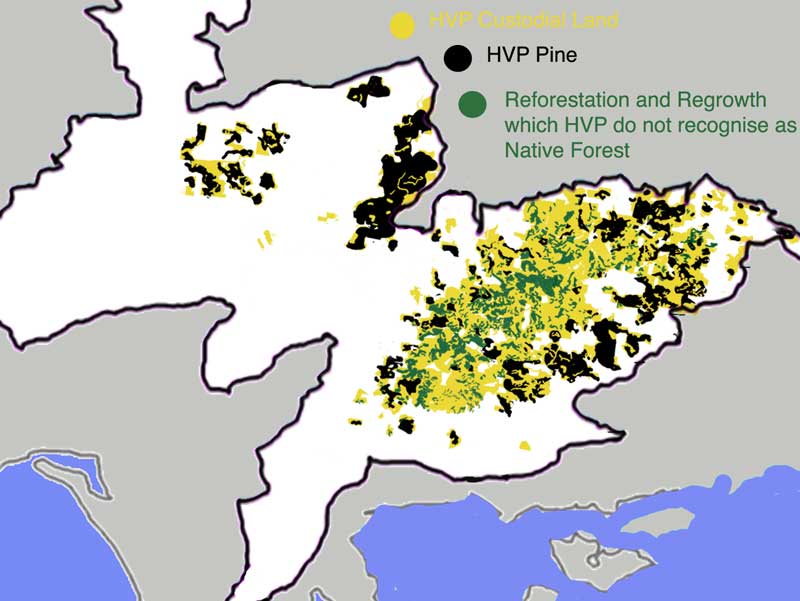
Yellow and Green : Native Forest
Yellow: The Areas which HVP acknowledge as Native Forest (approx 35000
ha.). They call it their "Custodial Land".
In their August 2008 press release on their plans for the Strzeleckis,
the Brumby Government also announced the protection of a further 15000
ha. of Strzelecki native forest. Don't get too excited. It is to remain
under HVP management and will not be given any reserve status. It has a
modicum of merit inasmuch as it proclaims these areas as official no-log
zones, if that wasn't already the case. We have letters from politicians
from 10 years ago, stating that these areas were already considered no-log
zones back then. Officially announcing as much now is fine, but this 15000
ha. is Native Forest that a plantation company has no claim to anyway.
Yes, HVP manage this land, but al lot of their landholdings (by our reckoning,
about 43,000 ha) are not plantation. Even by HVP's distorted reckoning
(they count the regrowth and reforestation as "plantation") they have some
35,000 ha. of "Custodial Land" - that is non-plantation land that they
have to manage but wont/ aren't allowed to/ wouldn't bother to log. In
the old forestry parlance it was land classified as "Unavailable or unsuitable
for timber harvesting" This 15000 ha. is part of HVP's Custodial Land,
those yellow bits in the map above. It is land that everyone agrees is
native Forest, and therefore is subject to all the usual native vegetation
clearing restrictions that apply to "private" land. By HVP's reckoning,
a few thousand hectares of this Custodial Land is potentially loggable,
but HVP are in the plantation business, and if they logged these areas
(assuming they were unlikely enough to get permission from the Shires to
do so, and were willing to lose their kudos as a plantation company) they
still wouldn't be allowed to establish plantations on these areas, as this
practice is not allowed in the State of Victoria. You can't clear Native
Forest to establish new plantations, they have to go on already
cleared land, or areas that are already plantation.
So, this 15,000 ha. is just some of HVP's Custodial Land. What about
the rest? Why not officially proclaim all of HVP's 35000 ha. of Custodial
Land no-log zones? It would have no impact on the timber supply, and it
would clear up quite a lot of uncertainty as to its environmental security.
Several variations on this proposal (to allow some logging of the Cores and Links) have been put to the Working party years ago. The first time it was roundly rejected. Some time later it was put forward again but this time even worse (HVP were to also be allowed to log certain bits of their Custodial Land), and due to some serious brain malfunctions, the Strzelecki Forest Community Group (The Strzelecki Working Party minus HVP) voted to support it. We instantly resigned in disgust.
Some more time passed, and in May 2008, the State Government announced the "in-principle" agreement, which was in the form it is now. This time, in a return to sanity, none of the SFCG supported it, but somehow the VNPA and the Wilderness Society had been hoodwinked into giving the ludicrous "log-then-protect" plan the thumbs-up. Gawd help us, there's a sucker born every minute!....
More time passed, and on 14th August 2008, it was announced that it was now a done deal. I wouldn't be surprised if the VNPA and Wilderness have woken up and withdrawn their support by now.
Conclusion: The Strzelecki forests need some balance and justice. It is quite feasible to protect 30,000 ha of Public land in a National Park. The Cores and Links should be part of this. The Cores and Links hould not be logged first. The experiment to privatise a State Forest has proved disastrous. Due to Government trickery HVP have been allowed to clearfell thousands of hectares of native forest and convert these areas to plantation since 1998. Enough is enough. All public land (apart from the pine plantations) leased to HVP should be returned to the public sphere and an appropriate amount be included in the national park. All reforestation and regrowth should regain their Native Forest status. The Maryvale mill should be drastically reducing their hardwood consumption, not increasing it.
- Kim Devenish and Julie Constable 23-Aug-2008